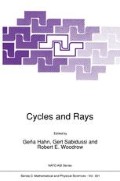Abstract
We give an introductory survey on concepts and results concerning harmonic functions on infinite graphs with the goal of describing the interplay between graph structure and potential theory. A particular emphasis is on the connection between the Martin boundary for harmonic functions and the space of ends of the underlying graph. A variety of results is described.
Access this chapter
Tax calculation will be finalised at checkout
Purchases are for personal use only
Preview
Unable to display preview. Download preview PDF.
References
R. Azencott and P. Cartier: Martin boundaries of random walks on locally compact groups. Proc. 6th Berkeley Symposium on Math. Statistics and Probability3 (1972), 87 – 129.
J. R. Baxter: Restricted mean values and harmonic functions. Trans. Amer. Math. Soc.167 (1972), 451 – 463.
J. R. Baxter: Harmonic functions and mass cancellation. Trans. Amer. Math. Soc.245 (1978), 375 – 384.
P. Cartier: Fonction harmoniques sur un arbre. Symposia Math. 9 (1972), 203 – 270.
G. Choquet and J. Deny: Sur l’équation de convolution µ= µ* σ. C.R. Acad. Sci. Paris250 (1960), 799 – 801.
Y. Derriennic: Marche aléatoire sur le groupe libre et frontière de Martin. Zeitschr. Wahrscheinlichkeitstheorie Verw. Geb.32 (1975), 261 – 276.
J. L. Doob: Discrete potential theory and boundaries. J. Math. Mech8 (1959), 433 – 458.
J. L. Doob, J. L. Snell and R. E. Williamson: Application of boundary theory to sums of independent random variables. Contributions to Probability and Statistics, Stanford Univ. Press (1960), 182 – 197.
P. Doyle and J. L. Snell: Random Walks and Electric Networks. Carus Math. Monographs, Math. Assoc. Amer., 1984.
E. B. Dynkin and M. B. Malyutov: Random walks on groups with a finite number of generators. Soviet Math. Doklady2 (1961), 399 – 402.
W. Feller: Boundaries induced by nonnegative matrics. Trans. Amer. Math. Soc.83 (1956), 19 – 54.
H. Freudenthal: Über die Enden diskreter Räume und Gruppen. Comment. Math. Helv.17 (1944), 1 – 38.
H. Furstenberg: Random walks and discrete subgroups of Lie groups. Advances in Probability and Related Topics, Vol. 1 (P. Ney, ed.), Dekker, New York (1971), 1 – 63.
R. Halin: Über unendliche Wege in Graphen. Math. Annalen157 (1964), 125 – 137.
D. Heath: Functions possessing restricted mean value properties. Proc. Amer. Math. Soc.41 (1973), 588 – 595.
P. L. Hennequin: Processus de Markoff en cascade. Ann. Inst. H. Poincaré18 (1963), 109 – 196.
H. A. Jung: Connectivity in infinite graphs. Studies in Pure Math. (L. Mirsky, ed.), Academic Press, New York (1971), 137 – 143.
J. G. Kemeny, J. L. Snell and A. W. Knapp: Denumerable Markov Chains. 2nd ed., Springer, New York — Heidelberg — Berlin, 1976.
V. A. Kaimanovich and A. M. Vershik: Random walks on discrete groups: boundary and entropy. Annals Probab. 11 (1983), 457 – 490.
T. Lyons: A simple criterion for transience of a reversible Markov chain. Annals Probab. 11 (1983), 393 – 402.
W. Magnus: Noneuclidean Tesselations and their Groups. Academic Press, New York, 1974.
C. St. J. A. Nash-Williams: Random walks and electric currents in networks. Proc. Cambridge Phil. Soc.55 (1959), 181 – 194.
P. Ney and F. Spitzer: The Martin boundary for random walk. Trans. Amer. Math. Soc.121 (1966), 116 – 132.
R. R. Phelps: Lectures on Choquet’s Theorem. Van Nostrand Math. Studies, Vol. 7, New York, 1966.
M. A. Picardello and W. Woess: Martin boundaries of random walks: ends of trees and groups. Trans. Amer. Math. Soc.302 (1987), 185 – 205.
M. A. Picardello and W. Woess: Harmonic functions and ends of graphs. Proc. Edinburgh Math. Soc.31 (1988), 457 – 461.
M. A. Picardello and W. Woess: A converse to the mean value property on homogeneous trees. Trans. Amer. Math. Soc in print
M. A. Picardello and P. Sjögren: Preprint, Univ. Maryland (1988).
N. Polat: Aspects topologiques de la séparation dans les graphes infinis. Math. Zeitschr.165 (1979), 73 – 100.
C. Series: Martin boundaries of random walks on Fuchsian groups. Israel J. Math.44 (1983), 221 – 242.
F. Spitzer: Principles of Random Walk. Van Nostrand, Princeton, 1974.
J. C. Taylor: The Martin boundaries of equivalent sheaves. Ann. Inst. Fourier20 (1970), 433 – 456.
C. Thomassen: Resistances and currents in infinite electrical networks. J. Combin. Theory Ser. B in print.
W. Veech: A zero-one law for a class of random walks and a converse to Gauss’ mean value theorem. Annals Math. 97 (1973), 189 – 216.
W. Veech: A converse to the mean value theorem for harmonic functions. Amer. J. Math97 (1975), 1007 – 1027.
W. Woess: A description of the Martin boundary for nearest neighbour random walks on free products. “Probability Measures on Groups”, Springer Led. Notes in Math.1210 (1986), 203 – 215.
W. Woess: Harmonic functions on infinite graphs. Rendiconti Sera. Mat. Fis. Milano56 (1986), 53 – 63.
W. Woess: Graphs and groups with tree-like properties. J. Combin. Theory Ser. B in print.
Author information
Authors and Affiliations
Editor information
Editors and Affiliations
Rights and permissions
Copyright information
© 1990 Kluwer Academic Publishers
About this chapter
Cite this chapter
Picardello, M.A., Woess, W. (1990). Ends of Infinite Graphs, Potential Theory and Electrical Networks. In: Hahn, G., Sabidussi, G., Woodrow, R.E. (eds) Cycles and Rays. NATO ASI Series, vol 301. Springer, Dordrecht. https://doi.org/10.1007/978-94-009-0517-7_15
Download citation
DOI: https://doi.org/10.1007/978-94-009-0517-7_15
Publisher Name: Springer, Dordrecht
Print ISBN: 978-94-010-6719-5
Online ISBN: 978-94-009-0517-7
eBook Packages: Springer Book Archive

